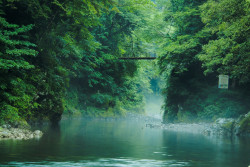
April 28, 2006
Big Trouble in Middle China
Or, How We Almost Froze on One of China’s Sacred Peaks
By Metropolis
Originally published on metropolis.co.jp on April 2006

Photos by Beau Miller
Summer is the perfect time to climb Mount Emei, a towering peak in central China’s Sichuan Province that is also central to the country’s Buddhist lore. As hikers progress upward along the steep trails, the sweltering heat abates, and the golden Jinding Temple appears majestic among the clouds at the summit.
We think.
It’s hard to say for sure; we chose to climb Emei in November. “Avoid the crowds,” we thought. Actually, the bit about the air cooling towards the top is true—so much so that our carefree expedition almost ended prematurely with us tired, freezing and hours from any sort of shelter, trapped on an endless staircase winding through beautiful forests of snow-covered bamboo.

Towering over the small dusty town of the same name, Emei is one of the four sacred peaks of the Chinese Buddhist tradition. Visitors come with myriad objectives, but most are looking for “something,” which can range from rare local herbs to religion. We ourselves were aiming for a scenic outdoors adventure with green trails, breathtaking vistas—and with any luck, monkeys.
We spent the day of our arrival on the grounds of the Baoguo Temple at the mountain’s base, eating and chatting with resident monks, clearing our minds, and preparing for the trek ahead. That evening, a head priest joined us in our quarters and, when not being interrupted by his cellphone, talked about his take on the good life, the cosmos and enlightenment. We also met a traveling mother and daughter from a neighboring province, accompanied by a businessman from Taiwan. The woman had come to Emei with the hope of expelling a demon that had evidently set up shop in her body. At one point, she turned toward us as if to spark up a conversation, but instead let out a shrill cry—and then asked if anyone had been able to make out “its words.” We wished her luck and rather expediently made our way back to our room.
We managed a few good hours of rest until the temple came to life with the sounds of bronze bells, drums and a musical mantra played on endless loop over loudspeakers. We dressed and started on our way, stopping for a while at Wannian Temple, about an hour up the trail, for a simple meal free of meat, eggs and fish.

In centuries past, hundreds of active monasteries dotted Emei’s many hills and peaks; today, just a few dozen remain. Much of the original architecture and bucolic charm has been lost to fire or thieves. But now, thanks to porters and ambitious construction companies, tourists don’t have to settle for what’s left of the antiquated structures—the bigger temples, tragically, are trying to modernize, keeping with the times.
As snow started to fall, we passed the 15km mark, and with not much else to occupy our minds, we computed the number of stairs we’d climbed: around 60,000. Our trail to the summit was 23km—or just 32,000 more steps. The beauty of the setting sun and falling snow was soon overshadowed by the threat of spending the night in the frozen wilderness. An hour passed and night fell. As it became harder and harder to discern, much less navigate the path through the woods, the snow kept falling.
Then, as if on cue, one of the mountain’s “stick-stick soldiers” came jostling down the stairs, cigarette drooped from his mouth, and gazed bemusedly upon us: two moronic “outsiders,” muscles cramped and sucking wind. Eager to help (for a fee) he called to another porter, who soon emerged, galloping down the treacherous path with ease. Attaching our packs to bamboo poles, we were soon charging up into the darkness.
Eventually, we arrived at a small village near the 3099m summit, and that evening, feasted with our guardian angels on local specialties infused with local roots and herbs, all washed down with heated grain alcohol. The next day, we made for the top—by gondola—and once there built a celebratory snowman. We also gazed down on the clouds that had looked oh so threatening just hours before.
As we were waiting in line for the bus back into town, there appeared a friendly primate, grinning, sending us on our way.
To reach Emei, take a minibus from Chengdu, which is served by several air carriers and is also a busy rail hub. The peak season for climbing Emei runs from April to September. (According to the Lonely Planet: “Snow and ice make winter trekking precarious.” No jokes.) The hike can range from 20km to 60km, and takes a full day at the least. Several temples offer cheap lodging along the way (in peak season). Alternately, a bus runs most of the way to the summit, with a gondola for the last leg.
[geo_mashup_map]







